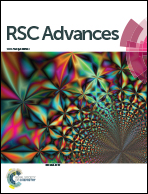Novel Pd-decorated amorphous Ni–B/C catalysts with enhanced oxygen reduction reaction activities in alkaline media
Abstract
Pd-decorated amorphous Ni–B/C (Pd@Ni–B/C) catalysts were successfully synthesized by modifying the surface of amorphous Ni–B/C particles with a trace amount of Pd (0.2 wt% to 1.5 wt%) through a simple chemical replacement method, which exhibited significantly improved oxygen reduction reaction (ORR) activities in alkaline media. X-ray diffraction (XRD), transmission electron microscopy (TEM) and X-ray photoelectron spectroscopy (XPS) characterization were carried out to prove the successful synthesis of amorphous Pd@Ni–B/C. The electrochemical performances of the prepared catalysts for ORR in alkaline media were evaluated by a linear sweep voltammetry (LSV) method using a potentiostat and a rotating disk electrode (RDE). Both the half-wave potential and the limiting current density of Pd-decorated Ni–B/C catalysts were improved compared with those of undecorated amorphous Ni–B/C catalysts. The electrocatalytic performance of 1.5 wt% Pd@Ni–B/C was comparable with that of 40 wt% Pd/C or Pt/C catalysts. Furthermore, the prepared catalyst showed high stability and methanol endurance ability. The low precious metal loading and comparable catalytic performance make Pd@Ni–B/C a very promising cathode catalyst in alkaline polymer electrolyte fuel cells (APEFCs).


 Please wait while we load your content...
Please wait while we load your content...